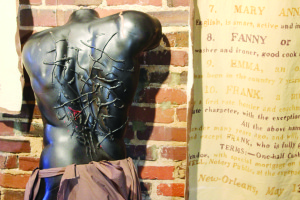

Dan Moore, founder of the Apex Museum, knew the importance of African Americans and their contributions to society. When Moore moved from Philadelphia to Atlanta he knew his history should be continuously celebrated.
Although Negro History Week was extended to Black History month, Black History Month is year long at The Apex Museum on Auburn Avenue.
Moore opened a museum with the mission of telling the story of people of color.
“In many places attention is only focused on the history of Black people during the shortest month of the year,” Moore said. “But for me and what we’re doing here, every month is black history month.”
Moore moved to Atlanta in 1975, with dreams of becoming a filmmaker. Opening a museum wasn’t always his goal but he was inspired after attending a banquet honoring Dr. Benjamin E. Mays.
“I sat there listening to all the accolades given to Dr. Mays and I asked myself why is there not a museum in Atlanta of all cities dedicated to preserving the history of African and African American people” Moore said.
From there, he went forward to open a global exhibit of African American History: The African American Panoramic Experience. First, Moore opened a small space on the Morris Brown College campus until he was able to open on Auburn Avenue in 1980.
Inside the Museum
One of the current exhibits in the Museum is Africa: The untold story. This exhibit was curated based on the works of Dr. Asa Hilliard, Georgia State Urban Education professor.
“He took groups to Egypt for many years. He said never let them begin our history with slavery,” Moore said. “We address the history of Africa and all its contributions prior to the slave trade.”
The exhibit consists of a timeline dating back to 6500 B.C., which includes African contributions to art, medicine, science and architecture. There is also a replica of The White Lion ship that brought slaves overseas. It depicts the horrifying conditions and troubles the slaves had to face with life size humans shackled on a ship.
A replica of the infamous ‘Door of No Return’ emulates the passageway captured Africans were forced to walk through to their enslavement. Visitors can walk through this small dark space and on the other side is ocean. In addition to the Door of No Return, there is a life size man, woman and child in shackles and torn clothing with auction posters around them illustrating the way humans were sold and families were torn apart.
Further, the other current exhibit is entitled ‘Sweet Auburn: Street of Pride’ is shown in the Museum’s Trolley Car Theatre and it is narrated by actress Cicely Tyson and social activist Julian Bond.
“In 1957 Fortune Magazine called Auburn Avenue the richest negro street in the world. Here you had African americans who literally developed this street.” Moore said.
Depicting the history of Auburn Avenue, the 17 minute film shares stories of African American pioneers John Wesley Dobbs and Dr. King, who played roles in the development of Sweet Auburn Avenue.
“Blacks were forced here. You couldn’t live on Peachtree Street so they owned the businesses, gas stations, churchs and beauty parlors. Entertainers like Aretha Franklin, Sam Cook and Ray Charles and many others performed right here at The Royal Peacock.”
The film also shows Alonzo Herndon, former slave, who opened Atlanta Life Insurance company and there is a replica of Yates and Milton drugstore equipped with a counter, medicine and customers. The first Yates and Milton Drugstore was at the corner of Auburn Avenue and Butler Street in the Odd Fellows Building.
“Yates and Milton bought the drug store from Moses Amos who was the first black pharmacist in Georgia and it was a block away from here” Moore said. “There’s a Very rich history on this avenue.”
Visitor Experiences
During Black History Month, Moore says some people only celebrate the Civil Rights era, and contributions of African Americans are often looked over.
“That’s only a glimpse of our existence. I don’t know if we celebrate the many inventions that we all have benefited from created by Black people under duress,” Moore said. “Because we have to realize most of these older inventions were done during a time when Black people were unable to do anything legally.”
In one of the rooms there is wall of an old Bellsouth calendar of over 50 Black contributions. The traffic signal and the mailbox a are included in an exhibition of African American patents Moore says Michael Jackson’s anti-gravity shoe leaves an impression on most visitors.
“There would be no Red Cross today if it were not for Dr. Charles Drew who taught how to store blood,” Moore said. “Or Mark dean with IBM who invented the first gigabyte chip
Things like this need to be celebrated so young people know they don’t have to be entertainers, there are many field open to them they can pursue to make a difference.”
When Moore first opened the museum he wanted visiotrs to have a wow experience and he says he is satisfied with the experience the museum has to offer today.
“I had a lady from Russia who came on a day we were closed but I let her in to browse around,” Moore said. “She wrote me Thank You for letting me in. I never knew that about Black people and I guarantee you when I get married and have children I will make sure they know the true story of the Black race.”
The museum celebrates its 35 year anniversary this year and they will soon be expanding for a state of the art experience. The Museum is open Tuesday through Saturday and students can visit for $5.
